On the summit of the “Heidelberg” mountain, next to the rock formations, you can find the remains of old gold mining tunnels (“test galleries”). In the Middle Ages, Bad Neualbenreuth was known for its rich gold deposits. The gold mineralized in the quartz veins in the slate of the “Waldsassener Schiefergebirge” mountain range. In the old shafts (and in the rocks), you can see those quartz veins. The primary mineralization of gold always takes place in quartz. Opposite the shafts the miners tried to reach the rock formation of the mountain range by surface mining. They dug away the slope down to the rock so that they could search for the quartz veins . But neither this method was successful.
In the past, the mountains “Heidelberg” and “Birkenberg” together were called “Hedelberg”. In miners’ language, the term “Hedel” refers to a fine, clear mud as well as to the finely crushed ore (almost looking like flour) produced in the stamping mill (“Pochwerk” or “Puchwerk”) . So the name “Hedelberg” is more likely to be the correct one for the mountain. Also, as mining activities of the late Middle Ages are documented at the foot of the “Heidelberg” mountain and at the inlet of the “Pointmühlbach” stream, which has its source in the Rinnlbrunnen spring at the Ringelfelsen rock. Likewise, on the “Hammersbach” stream near Poppenreuth and the course of the “Silberbrunnen” stream near the village “Pilmersreuth am Wald”. There you can still find that fine, clear mud, from which the miners once tried to wash gold orespan for gold.


